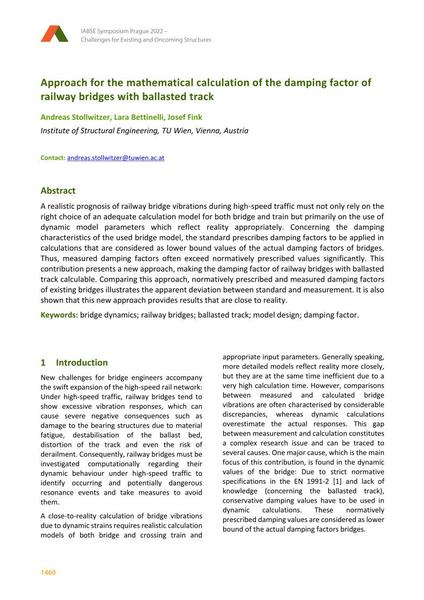Approach for the mathematical calculation of the damping factor of railway bridges with ballasted track

|
|
|||||||||||
Détails bibliographiques
| Auteur(s): |
Andreas Stollwitzer
(Institute of Structural Engineering, TU Wien, Vienna, Austria)
Lara Bettinelli (Institute of Structural Engineering, TU Wien, Vienna, Austria) Josef Fink (Institute of Structural Engineering, TU Wien, Vienna, Austria) |
||||
|---|---|---|---|---|---|
| Médium: | papier de conférence | ||||
| Langue(s): | anglais | ||||
| Conférence: | IABSE Symposium: Challenges for Existing and Oncoming Structures, Prague, Czech Republic, 25-27 May 2022 | ||||
| Publié dans: | IABSE Symposium Prague 2022 | ||||
|
|||||
| Page(s): | 1460-1467 | ||||
| Nombre total de pages (du PDF): | 8 | ||||
| DOI: | 10.2749/prague.2022.1460 | ||||
| Abstrait: |
A realistic prognosis of railway bridge vibrations during high-speed traffic must not only rely on the right choice of an adequate calculation model for both bridge and train but primarily on the use of dynamic model parameters which reflect reality appropriately. Concerning the damping characteristics of the used bridge model, the standard prescribes damping factors to be applied in calculations that are considered as lower bound values of the actual damping factors of bridges. Thus, measured damping factors often exceed normatively prescribed values significantly. This contribution presents a new approach, making the damping factor of railway bridges with ballasted track calculable. Comparing this approach, normatively prescribed and measured damping factors of existing bridges illustrates the apparent deviation between standard and measurement. It is also shown that this new approach provides results that are close to reality. |
||||
| Copyright: | © 2022 International Association for Bridge and Structural Engineering (IABSE) | ||||
| License: | Cette oeuvre ne peut être utilisée sans la permission de l'auteur ou détenteur des droits. |
||||
